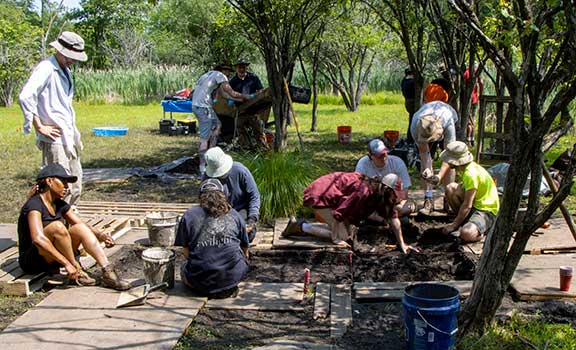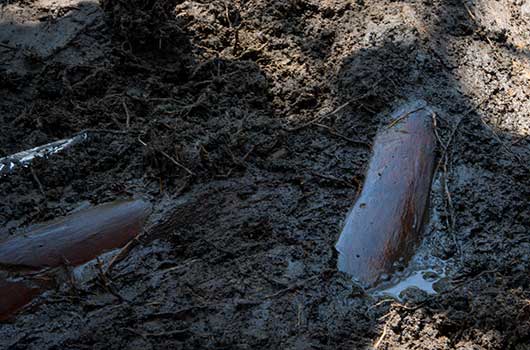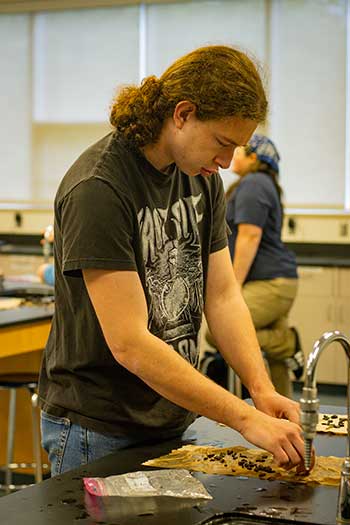Mastodon Dig is Once-in-a-Lifetime Event
July 8, 2025
Quite literally in their own backyard in Orange County this Summer, 12 SUNY Orange students and two professors just recently completed a once-in-a-lifetime field experience course in which they unearthed the partial remains of a mastodon estimated to be between 10,000 and 13,000 years old.
For six weeks, under the watchful eyes of professor Dr. Cory Harris and instructor Anthony Soricelli, the students excavated several one-meter-by-one-meter test units in the hopes of finding additional remains on the heels of a discovery in September 2024 of two mastodon teeth and an intact lower jaw (with teeth) on the property of a private residence near Middletown.
Orange County could be considered the epicenter of mastodon discovery in New York, with approximately one-third of the state’s finds located in the county.
By all accounts, the summer field course was a resounding success as the SUNY Orange team uncovered multiple vertebrae (including the atlas vertebra), additional jaw fragments, and ribs, all of which are believed to belong to the same Ice Age mastodon. The atlas bone serves as a base for the skull by bearing its weight and maintaining its upright position. Those items have been shipped to the New York State Museum for examination and curation. The group also located a series of smaller pieces of unidentified bones and skeletal fragments, many of which are currently stored at the College’s Middletown campus.
This is such a big deal. How often can you be in the right place at the right time to have a once-in-a-lifetime experience? ”

Throughout the process, the SUNY Orange team has been collaborating with Dr. Robert Feranec and his team at the New York State Museum. Feranec is director of research and collections, as well as curator of Pleistocene vertebrate paleontology. He has provided guidance and support for the students as they meticulously tackled a project that is truly logging local history, and hosted the group for a behind-the-scenes tour of the museum on July 2, further broadening the students’ understanding of how their work this Summer will support museum efforts to educate New Yorkers young and old for years to come.
“After working with Bob to excavate the jaw in the Fall, I hoped we’d find more remains this Summer, but this worked out much better than I could have imagined,” Harris, chair of the College’s Behavioral Sciences Department and a professor of anthropology and sociology, said. “For our students, they have been exposed to a level of experience and expertise that is uncommon at a community college. They are learning about geology, archeology, anthropology and paleontology.
“Bob has been a great partner and we’ve all learned a lot from him. He has been generous with his time and advice,” Harris said. “Additionally, the homeowners were tremendously gracious in granting us further access to their property. They embraced the opportunity to share this discovery with our students and it was important to them that our students had a great experience.”
Once the jaw was unearthed and it was apparent more remains might be discoverable, it was important to SUNY Orange President Dr. Kristine Young and her academic leadership team to support Harris and Soricelli, a geology instructor, in organizing the summer class. The homeowners had shown great trust in originally reaching out to the College in the Fall, and the burgeoning partnership with the NYS Museum was uniting SUNY Orange and the museum in a shared mission of uncovering and preserving history, with students at the heart of the project.
“When I visited the site, it filled my heart to see our students out there digging, sifting, discovering, and learning,” Young said. “SUNY Orange was uniquely positioned. I’m so proud of our faculty for stepping up to offer this opportunity, and just as proud of our students for grabbing hold of it with both hands. Dr. Harris was ready to lead this effort, and Professor Soricelli brought the geological expertise that elevated the entire experience. It’s the kind of moment that reminds you what’s possible when talent meets opportunity at community colleges.”
Only a few of the students in the class have plans to pursue an archeological or anthropological career, but the chance to reach into the Earth and possibly be the first human to touch the remains of a prehistoric mammal was too good to pass up for those in the class studying art, chemistry, math, visual communications, biology or history. And while many of the students arrived at the first day of class on May 27 with little to no archeological experience, the group quickly formed into a cohesive team.
“This is such a big deal,” explained student Kierra Moore, a Cornwall resident who also works for the state’s Office of Parks, Recreation and Historic Preservation. “How often can you be in the right place at the right time to have a once-in-a-lifetime experience?”
Asked what the best part of this experience has been, Moore shared without hesitation: “The people. As much as I loved digging up this mastodon, it really was the people and everyone being able to ‘embrace the suck’ together (the weather, the bugs, the mud) and just lift everyone up.”
 “I’ve learned a lot. I didn’t know we would find this much. I mean the ribs. I can’t
believe we found that,” said Greenwood Lake resident Sadie Hankins, who easily identified
what memory will stay with her the longest. “The people will be the long-term memory
for me. Everyone collaborated so well and in this rare opportunity, that really added
to it.”
“I’ve learned a lot. I didn’t know we would find this much. I mean the ribs. I can’t
believe we found that,” said Greenwood Lake resident Sadie Hankins, who easily identified
what memory will stay with her the longest. “The people will be the long-term memory
for me. Everyone collaborated so well and in this rare opportunity, that really added
to it.”
Student Brighton Blake was so energized by his experience that he is considering changing his liberal arts focus from social sciences to geology or archaeology.
“This has been so cool. I was surprised how shallow the bones were. It might be the most-shallow mastodon discovery in Orange County history,” Blake suggested. “It was interesting to learn about the attention to detail we needed as we mapped and graphed the units to show where we found the bones. But it was bittersweet to be there for only six weeks. I think there is a lot more there.”
Harris, too, believes there is more of this gentle giant just beneath the surface. More than the excavation team could expose in just six weeks. But for now, in accordance with archeological best practices, the site has been returned to its original state. The students’ detailed charts, graphs and notes remain as a map for future crews to possibly pick up where this 2025 team left off.
And the memories of delicately excavating skeletal remains of a mammoth prehistoric mastodon will last a lifetime for a dozen SUNY Orange students and two professors who found themselves leading a once-in-a-lifetime project.

- NY State Museum Press Release (date TBA)
- Lasting Impact on Learning
- 2025 Excavation Crew
- Original 2024 Discovery
- Sugar, The Mastodon

